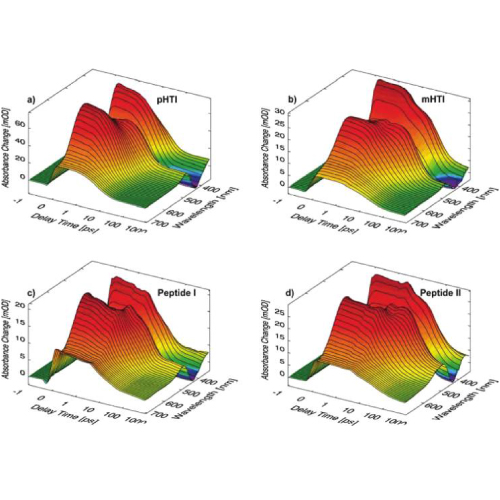Light-Switchable Hemithioindigo–Hemistilbene-Containing Peptides: Ultrafast Spectroscopy of the Z → E Isomerization of the Chromophore and the Structural Dynamics of the Peptide Moiety
16-Mar-2012
The Journal of Physical Chemistry B, 2012, DOI: 10.1021/jp300982a, 116 (14), pp 4181–4191 published on 16.03.2012
The Journal of Physical Chemistry B, online article
Two hemithioindigo–hemistilbene (HTI) derivatives, designed to operate as structural switches in peptides, as well as two HTI peptides are characterized by ultrafast spectroscopy in the visible and the infrared. The two HTI switches follow the reaction scheme published for other HTI compounds with a picosecond excited state reaction (τ1 ≈ 6 ps) and isomerization from Z to E with τ2 = 13 and 51 ps. As compared to the isolated chromophores, the isomerization reaction is slowed down in the chromopeptides to τ2 = 24 and 69 ps. For the smaller peptide containing 6 amino acids, the structural changes of the peptide moiety observed via the IR spectrum in the amide I band follow the isomerization of the molecular switch closely. In the larger cyclic chromopeptide, containing 20 amino acids and mimicking a β-hairpin structure in the Z-form of the chromophore, the peptide moiety also changes its structure during isomerization of the chromophore. However, the IR spectrum at the end of the observation period of 3 ns deviates significantly from the stationary difference spectrum. These signatures indicate that strong additional structural changes, e.g., breaking of interchain hydrogen bonds, also occur on longer time scales.











